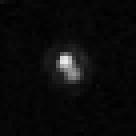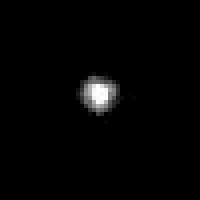
20000 Varuna, provisional designation 2000 WR106, is a large trans-Neptunian object in the Kuiper belt. It was discovered in November 2000 by American astronomer Robert McMillan during a Spacewatch survey at the Kitt Peak National Observatory. It is named after the Hindu deity Varuna, one of the oldest deities mentioned in the Vedic texts.

38628 Huya ( hoo-YAH), provisional designation 2000 EB173, is a binary trans-Neptunian object located in the Kuiper belt, a region of icy objects orbiting beyond Neptune in the outer Solar System. Huya is classified as a plutino, a dynamical class of trans-Neptunian objects with orbits in a 3:2 orbital resonance with Neptune. It was discovered by the Quasar Equatorial Survey Team and was identified by Venezuelan astronomer Ignacio Ferrín in March 2000. It is named after Juyá, the mythological rain god of the Wayuu people native to South America.
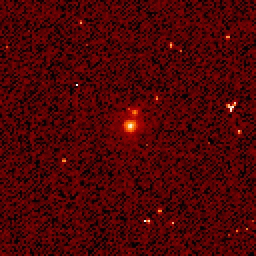
47171 Lempo, or as a binary (47171) Lempo–Hiisi (also known as 1999 TC36), is a trans-Neptunian object and trinary system from the Kuiper belt, located in the outermost regions of the Solar System. It was discovered on 1 October 1999, by American astronomers Eric Rubenstein and Louis-Gregory Strolger during an observing run at Kitt Peak National Observatory in Arizona, United States. Rubenstein was searching images taken by Strolger as part of their Nearby Galaxies Supernova Search project. It is classified as a plutino with a 2:3 mean-motion resonance with Neptune and is among the brighter TNOs. It reached perihelion in July 2015. This minor planet was named after Lempo from Finnish mythology.

(55565) 2002 AW197 is a classical, non-resonant trans-Neptunian object from the Kuiper belt in the outermost region of the Solar System, also known as a cubewano. With a likely diameter of at least 700 kilometers (430 miles), it is approximately tied with 2002 MS4 and 2013 FY27 (to within measurement uncertainties) as the largest unnamed object in the Solar System. It was discovered at Palomar Observatory in 2002.
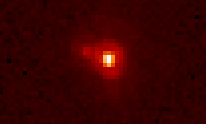
(55637) 2002 UX25 is a trans-Neptunian object that orbits the Sun in the Kuiper belt beyond Neptune. It briefly garnered scientific attention when it was found to have an unexpectedly low density of about 0.82 g/cm3.

58534 Logos, or as a binary system (58534) Logos-Zoe, is a trans-Neptunian object and binary system from the classical Kuiper belt, approximately 77 kilometers (48 miles) in diameter. The bright cubewano belongs to the cold population and has a 66-kilometer sized companion named Zoe. The system mass is (4.58±0.07)×1017 kg.

(208996) 2003 AZ84 is a trans-Neptunian object with a possible moon located in the outer regions of the Solar System. It is approximately 940 kilometers across its longest axis, as it has an elongated shape. It belongs to the plutinos – a group of minor planets named after its largest member Pluto – as it orbits in a 2:3 resonance with Neptune in the Kuiper belt. It is the third-largest known plutino, after Pluto and Orcus. It was discovered on 13 January 2003, by American astronomers Chad Trujillo and Michael Brown during the NEAT survey using the Samuel Oschin telescope at Palomar Observatory.

79360 Sila–Nunam, provisional designation 1997 CS29, is a cold classical Kuiper belt object (cubewano) and binary system made up of components of almost equal size, called Sila and Nunam, orbiting beyond Neptune in the Solar System. The name of the system is the combined names of the two bodies, Sila and Nunam.
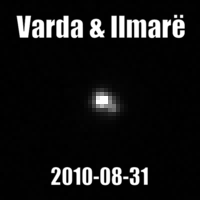
174567 Varda (provisional designation 2003 MW12) is a binary trans-Neptunian planetoid of the resonant hot classical population of the Kuiper belt, located in the outermost region of the Solar System. Its moon, Ilmarë, was discovered in 2009.

(26308) 1998 SM165 is a resonant trans-Neptunian object and binary system from the Kuiper belt in the outermost regions of the Solar System. It was discovered on 16 September 1998, by American astronomer Nichole Danzl at the Kitt Peak National Observatory in Arizona. It is classified as a twotino and measures approximately 280 kilometers in diameter. Its minor-planet moon was discovered in 2001.

Salacia is a large trans-Neptunian object in the Kuiper belt, approximately 850 km (530 mi) in diameter. It was discovered on 22 September 2004, by American astronomers Henry Roe, Michael Brown and Kristina Barkume at the Palomar Observatory in California, United States. Salacia orbits the Sun at an average distance that is slightly greater than that of Pluto. It was named after the Roman goddess Salacia and has a single known moon, Actaea.

42355 Typhon (; prov. designation: 2002 CR46), is a scattered disc object that was discovered on February 5, 2002, by the NEAT program. It measures 162±7 km in diameter, and is named after Typhon, a monster in Greek mythology.

229762 Gǃkúnǁʼhòmdímà (provisional designation 2007 UK126) is a trans-Neptunian object and binary system from the extended scattered disc, located in the outermost region of the Solar System. It was discovered on 19 October 2007 by American astronomers Megan Schwamb, Michael Brown, and David Rabinowitz at the Palomar Observatory in California and measures approximately 600 kilometers (400 miles) in diameter. This medium-sized TNO appears to be representative of a class of mid-sized objects under approximately 1000 km that have not collapsed into fully solid bodies. Its 100-kilometer moon was discovered by Keith Noll, Will Grundy, and colleagues with the Hubble Space Telescope in 2008, and named Gǃòʼé ǃHú.
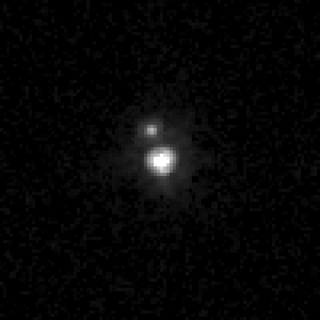
Vanth is a natural satellite or moon of the trans-Neptunian dwarf planet 90482 Orcus. It was discovered by Michael Brown and Terry-Ann Suer using images taken by the Hubble Space Telescope on 13 November 2005. The moon has a diameter of 443 km (275 mi), making it about half the size of Orcus and the third-largest moon of a trans-Neptunian object. Vanth is massive enough that it shifts the barycenter outside of Orcus, forming a binary system in which the two bodies revolve around the barycenter, much like the Pluto–Charon system. It is hypothesized that both systems formed similarly, most likely by a giant impact early in the Solar System's history. In contrast to Orcus, Vanth has a darker and slightly redder surface that apparently lacks exposed water ice, resembling primordial Kuiper belt objects.

66652 Borasisi, or as a binary (66652) Borasisi-Pabu, is a binary classical Kuiper belt object. It was discovered in September 1999 by Chad Trujillo, Jane X. Luu and David C. Jewitt and identified as a binary in 2003 by K. Noll and colleagues using the Hubble Space Telescope.

Actaea, officially (120347)Salacia I Actaea, is a natural satellite of the classical Kuiper belt planetoid 120347 Salacia. Its diameter is estimated 300 km (190 mi), which is approximately one-third the diameter of Salacia; thus, Salacia and Actaea are viewed by William Grundy et al. to be a binary system. Assuming that the following size estimates are correct, Actaea is about the sixth-biggest known moon of a trans-Neptunian object, after Charon (1212 km), Dysnomia (700 km), Vanth (443 km), Ilmarë (326 km) and Hiʻiaka (320 km), but possibly also Hiisi.

Ilmarë, or Varda I, full designation 174567 Varda I Ilmarë, is the single known natural satellite of the Kuiper belt object 174567 Varda. It was discovered by Keith Noll et al. in 2009, at a separation of about 0.12 arcsec, using discovery images taken by the Hubble Space Telescope on 26 April 2009, and reported in 2011. At approximately 326 km in diameter (about 45% that of its primary), it is the fourth or fifth-largest known moon of a trans-Neptunian object, after Pluto I Charon, Eris I Dysnomia, Orcus I Vanth and very possibly Haumea I Hiʻiaka. Assuming that Ilmarë has the same albedo and density as Varda, Ilmarë would constitute approximately 8.4% of the system's mass, approximately 2.2×1019 kg.
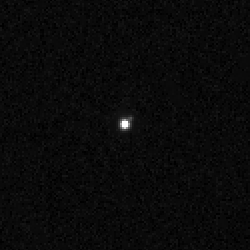
(532037) 2013 FY27 is a trans-Neptunian object and binary system that belongs to the scattered disc (like Eris). Its discovery was announced on 31 March 2014. It has an absolute magnitude (H) of 3.2. 2013 FY27 is a binary object, with two components approximately 740 kilometres (460 mi) and 190 kilometres (120 mi) in diameter. It is the ninth-intrinsically-brightest known trans-Neptunian object, and is approximately tied with 2002 AW197 and 2002 MS4 (to within measurement uncertainties) as the largest unnamed object in the Solar System.

(524366) 2001 XR254, provisional designation 2001 XR254, is a trans-Neptunian object and binary system from the classical Kuiper belt, located in the outermost region of the Solar System. The cubewano belongs to the cold population and measures approximately 171 kilometers (110 miles). It was first observed on 10 December 2001, by astronomers at the Mauna Kea Observatory, Hawaii. Its 140-kilometer sized companion was discovered by the Hubble Space Telescope in June 2006.

(275809) 2001 QY297 is a trans-Neptunian object from the classical Kuiper belt, located in the outermost region of the Solar System. The binary classical Kuiper belt object belongs to the cold population.
